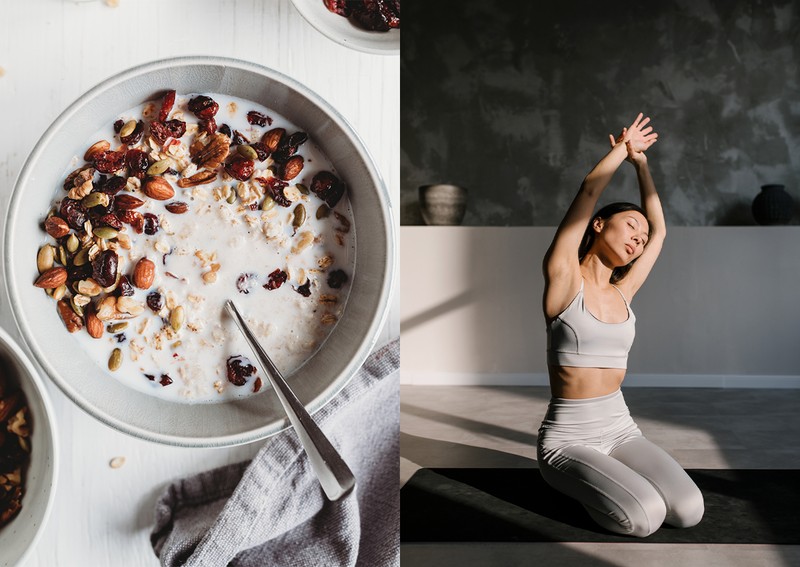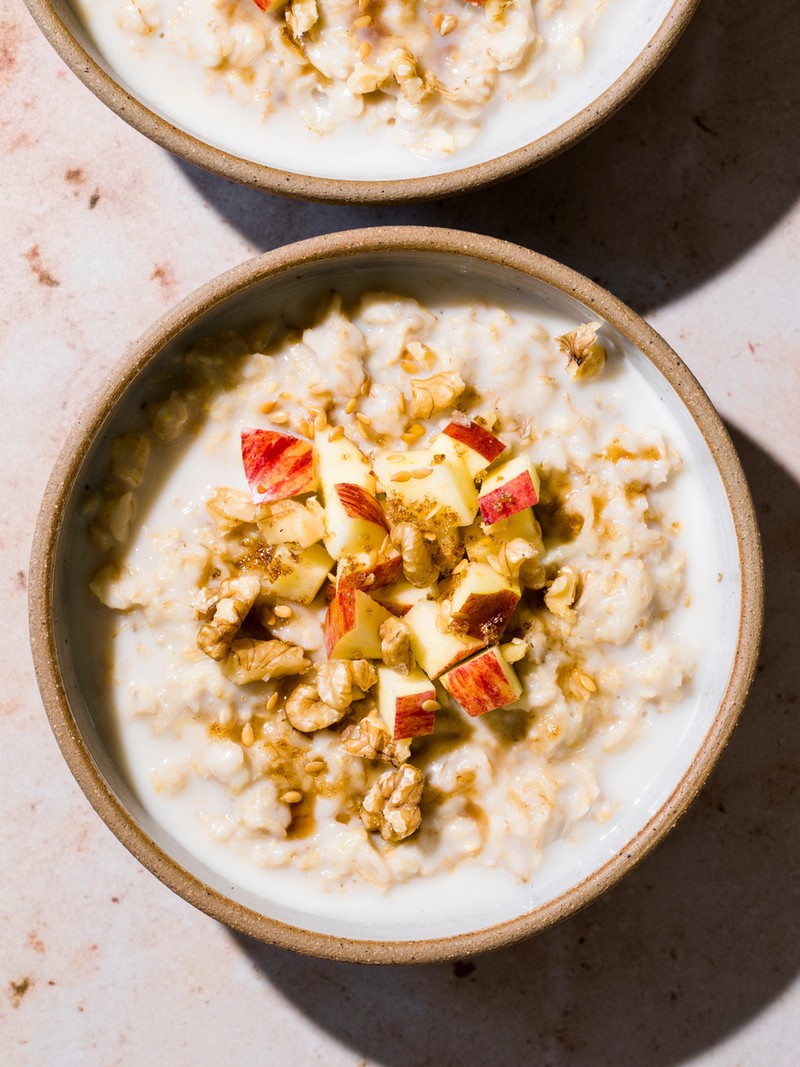How To Fuel Every Type Of Workout
RUNNING
Carbs Are Your Main Energy Source
“Carbs are a runner’s preferred energy source. Stored in your muscles in the form of glycogen, carbs are converted back into glucose as your glucose levels drop during exercise. This helps your body maintain a steady glucose supply, preventing fatigue. One of the tell-tale signs that you’re not fuelling your running properly with adequate carbs is consistent fatigue or low energy, a decline in your running performance, or an inability to complete your usual weekly training. If you run regularly, most of your calories should come from carbs – aim for around 60% of your total daily intake. Focus on a consistent intake throughout the day of complex carbs like wholegrains, fruits and vegetables. The exception is if you need a quick pre-workout boost. If you have less than an hour until your session, opt for easy-to-digest carbs like bananas or toast with honey or jam.” – Melanie Wilkinson, sports nutritionist at The Body Lab
Protein is Just As Important
“Due to the way your muscles work during a run, it’s critical to consume adequate protein to keep muscles strong. Protein also plays a role in both optimising bone health and immunity, so aim for around 2g of protein per kg of your bodyweight if you’re running regularly. Muscle protein synthesis in response to a meal has been found to be elevated for up to 24 hours post-exercise, so think about your protein intake across the day, not just immediately after your session. Don’t cut calories if you’re a keen runner, either. Ensuring optimal calories daily is vital to fuel running performance. Look for changes in your body composition, a reduction in performance or feelings of tiredness – if you notice significant changes, chances are you should be fuelling more.” – Lily Chapman, performance coach & sport nutritionist at P3RFORM
A 3:1 Ratio Is Optimal
“After a high-intensity session, it’s important to replenish glycogen stores in the body, and this is more efficient when done shortly afterwards. Alongside this, include 20-25g of protein to aid muscle repair – a 3:1 ratio of carbs to protein is a great balance. There’s no need to overcomplicate it – think a tuna and avocado sandwich or bagel; homemade egg fried rice with peas; Greek yoghurt with muesli, nuts and fresh fruit; homemade chicken and tomato pasta; or a smoothie made with protein powder and banana.” – Rob Hobson, registered sports nutritionist
Sports Drinks Can Replace Electrolytes
“Water will suffice for runs under 60 minutes, but if you’re running for longer than an hour, think about replacing lost electrolytes with a supplement or sports drink. Magnesium and potassium are two key electrolytes – they can be found in nuts, seeds, wholegrains, bananas and sweet potatoes – so up your intake of these foods if you’re exercising intensely.” – Melanie
Iron Is Important At Certain Points In Your Cycle
“Iron transports oxygen to the working muscles, thereby sustaining performance. Iron is particularly important for menstruating women due to the iron loss that occurs during your period. Studies show runners have higher iron needs, so consider topping up your intake with lean meat, green vegetables and fortified cereals.” – Melanie
Your Vitamin D Level Matters
“Vitamin D is needed for strong, healthy bones, and research shows sub-optimal intake of vitamin D can greatly increase the risk of stress fracture in runners. Evidence also suggests low vitamin D levels increase the risk of muscle and other soft tissue injuries, especially in the lower half of the body. Vitamin D will also support the immune system, which can be affected by high-intensity training.” – Melanie
STRENGTH
It’s All About Balance
“Protein and carbs are the most important macros to consider when strength training. Protein supports muscle repair and growth, while carbs provide the energy for an intense workout. However, healthy fats also play a role in strength gains as they aid the absorption of fat-soluble vitamins like vitamins A, D, E and K, which are key for optimal muscle function. Vitamin E, for example, helps tackle inflammation caused by exercise. Eating more wholegrains, seeds, nuts and dark green leafy vegetables will protect cells against damage and enhance recovery, immune health and muscle growth.” – Abigail Roberts, sports nutritionist at Bulk
Protein Should Be Spread Across The Day
“When resistance training is part of your routine, studies show the body needs a regular supply of amino acids – the building blocks of protein – to keep you fuelled and to build lean muscle. If you are looking to tone up, aim for 1.6-2g per kg of your bodyweight daily, ideally distributed every three to four hours across the day. Aim for at least 25g of protein in each meal.” – Lily
A Low-Carb Diet Isn’t A Good Idea
“Although carbs don’t play as direct a role as protein in building muscle, they’re still key to the process. To promote muscle growth and sculpt a leaner body, you need to progressively overload to stress muscle fibres. Without carbs, you wouldn’t have the energy to exercise at the necessary intensity to see change. Consuming carbs will also delay fatigue onset and reduce the rate of perceived exertion.” – Lily
Creatine Can Help Build Lean Muscle
“Creatine is an amino acid that occurs naturally in the body, but taking it in supplement form can boost its availability to our muscles to increase performance. It works by helping the body to use the energy stored in the muscles when you are lifting heavy weights, meaning you can work harder, lift heavier and feel less tired during your workouts. Creatine supplementation can also help muscles recover faster after a workout. One study showed that female athletes who supplemented with creatine not only had greater upper body strength, but also had a significant reduction in the percentage of body fat after five weeks of supplementing. Aim for 3-5g daily.” – Lily

HIIT
A Carb-Rich Snack Will Provide An Energy Boost
“For a HIIT workout, our metabolism prefers to use carbs for fuel, so it’s a good idea to have a carb-rich snack at least 30 minutes before your session – try a banana or a couple of dates. This will give your body the energy it needs. If you are doing an interval session that’s longer than 60 minutes, you’ll need to consume carbs during your workout to maintain optimal blood glucose to enhance performance and delay fatigue. An additional 30g of carbs per hour is a good starting point.” – Marine Melamed, nutritionist at Lumen
A HIIT Workout Will Break Down Muscle
“Since muscles are broken down during a HIIT workout, it’s essential to consume enough protein and carbs to repair damaged tissue. Ideally eat a balanced meal within three hours of a HIIT workout, and then for a post-workout meal, opt for a balanced meal that consists of protein, healthy fats and complex carbs. Build your plate with non-starchy vegetables, a portion of chicken, fish or tofu, some legumes or wholegrains, and a few nuts and seeds for a dose of healthy fats.” – Marine
Increased Recovery Time Is A Sign Of Under-Fuelling
“Fuelling your body properly is critical not just for performance, but for your overall health. Working your anaerobic system, HIIT is intense, so it’s important to fuel your body well if it’s part of your routine. If you’re experiencing frequent coughs and colds, it could be a sign your immune system is compromised due to inadequate fuelling, and the same goes for mood changes or irritability. Some women may also experience changes to their menstrual cycle as a result of under-fuelling.” – Melanie
YOGA & PILATES
It's Better To Do Yoga On An Empty Stomach
“Traditional yogis will recommend practising on an empty stomach to optimise energy levels and to maintain balance. If you have a fast metabolism or low blood sugar on waking, a handful of nuts or some berries can provide sustained energy if you have an early class. After your class, have a substantial breakfast, as your digestive system is most active in the morning. Try a smoothie bowl with protein powder, greens, berries, avocado and chia seeds; overnight oats; or eggs, avocado and salmon with a slice of sourdough toast. If you are exercising in the evening, opt for a lighter dinner with a focus of eating more earlier in the day. A soup or salad with a source of protein like boiled eggs or tempeh are good supper options after a later yoga class.” – Mays Ali-Ali, nutritionist & yoga teacher
The Body Thrives On Fat When Working At A Lower Intensity
“During low-intensity workouts, the body is better able to utilise fat for fuel, meaning you don’t need to fuel up with carbs before yoga or Pilates. Aim to have a light snack a couple of hours before – this will allow enough time for digestion and to prevent discomfort while moving through different poses. Good pre-workout snacks include a handful of nuts or Greek yoghurt. If you’re not hungry, it’s okay to perform these workouts in a fasted state, as your body can utilise your fat stores for energy.” – Marine
Magnesium Can Help You Avoid Cramp
“During yoga and Pilates, you often hold poses for longer periods, which can lead to muscle cramps. The best way to avoid this is to ensure you have enough magnesium – good sources include dark chocolate and dark green leafy vegetables. Also consider supplementing with magnesium glycinate, which helps with energy, mood and stress. You may also experience pins and needles during yoga – if this happens regularly, it could be a sign of a vitamin B12 deficiency.” – Mays
Hot Yoga Can Deplete Nutrients
“If you’re into hot yoga, consider taking some electrolytes after a class, especially if you tend to sweat heavily. Either add an electrolyte sachet to a large glass of water or add salt to your post-workout meal. However, this isn’t necessary for shorter classes in normal temperatures or for those that don’t sweat as much. When it comes to food after a hot yoga class, choose something light – scrambled eggs on wholemeal toast, porridge with fresh fruit and nuts, or a baked sweet potato with grilled chicken or tofu and vegetables.” – Rob
For more information, visit TheBodyLabLondon.com, P3RFORM.co.uk, RobHobson.co.uk, Bulk.com, Lumen.me & HealthyMays.com
DISCLAIMER: Features published by SheerLuxe are not intended to treat, diagnose, cure or prevent any disease. Always seek the advice of your GP or another qualified healthcare provider for any questions you have regarding a medical condition, and before undertaking any diet, exercise or other health-related programme.
DISCLAIMER: We endeavour to always credit the correct original source of every image we use. If you think a credit may be incorrect, please contact us at info@sheerluxe.com.


